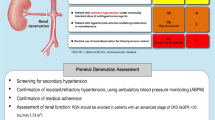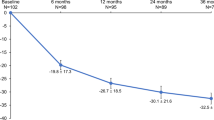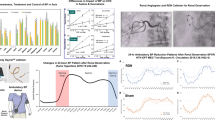Abstract
The recent evidence regarding the effectiveness of renal denervation (RDN) in blood pressure control is becoming increasingly substantial. However, many studies have excluded populations with severely impaired kidney function, even though these individuals have a higher prevalence of hypertension compared to the general population, and controlling their blood pressure is more challenging. The effectiveness and safety of RDN in patients with severe chronic kidney disease (CKD) lack strong evidence support. Concerns about worsening kidney function still exist, particularly in patients with CKD stage 5. We conducted an observational study involving 10 patients who were using at least 3 different antihypertensive medications and had an estimated glomerular filtration rate (eGFR) < 45 mL/min/1.73 m2 but had not undergone dialysis. For these patients, we performed RDN via the radial artery approach, with the assistance of carbon dioxide (CO2) angiography. Utilizing this approach, the systolic 24-hour ambulatory blood pressure monitoring did not exhibit a significant decrease at 3 months; however, a significant reduction was observed at 6 months after RDN. We also minimized contrast agent usage, observed no kidney function decline 3 months post-RDN, and experienced no vascular-related complications. Using the radial artery approach and CO2 angiography assistance for RDN may be an effective and safe blood pressure control method for patients with severe kidney impairment.

This is a preview of subscription content, access via your institution
Access options
Subscribe to this journal
Receive 12 print issues and online access
$259.00 per year
only $21.58 per issue
Buy this article
- Purchase on Springer Link
- Instant access to full article PDF
Prices may be subject to local taxes which are calculated during checkout




Similar content being viewed by others
References
Horowitz B, Miskulin D, Zager P. Epidemiology of hypertension in CKD. Adv Chronic Kidney Dis. 2015;22:88–95.
Teo BW, Chan GC, Leo CCH, Tay JC, Chia Y-C, Siddique S, et al. Hypertension and chronic kidney disease in Asian populations. J Clin Hypertens. 2021;23:475–80.
Tedla FM, Brar A, Browne R, Brown C. Hypertension in chronic kidney disease: navigating the evidence. Int J Hypertens. 2011;2011:132405.
An J, Kurella Tamura M, Odden MC, Ni L, Thomas I-C, Montez-Rath ME, et al. Prevalence of apparent treatment-resistant hypertension in chronic kidney disease in two large US Health Care Systems. Clin J Am Soc Nephrol. 2022;17:1457–66.
Burnier M, Damianaki A. Hypertension as cardiovascular risk factor in chronic kidney disease. Circ Res. 2023;132:1050–63.
Ku E, Lee BJ, Wei J, Weir MR. Hypertension in CKD: core curriculum 2019. Am J Kidney Dis. 2019;74:120–31.
Salem MM. Pathophysiology of hypertension in renal failure. Semin Nephrol. 2002;22:17–26.
Paton JFR, Raizada MK. Neurogenic hypertension. Exp Physiol. 2010;95:569–71.
Grassi G, Bertoli S, Seravalle G. Sympathetic nervous system: role in hypertension and in chronic kidney disease. Curr Opin Nephrol Hypertens. 2012;21:46–51.
Guber K, Kirtane AJ. Renal sympathetic denervation for hypertension. Kidney Int Rep. 2022;7:2129–40.
Bhatt DL, Vaduganathan M, Kandzari DE, Leon MB, Rocha-Singh K, Townsend RR, et al. Long-term outcomes after catheter-based renal artery denervation for resistant hypertension: final follow-up of the randomised SYMPLICITY HTN-3 Trial. Lancet 2022;400:1405–16.
Mahfoud F, Mancia G, Schmieder RE, Ruilope L, Narkiewicz K, Schlaich M, et al. Cardiovascular risk reduction after renal denervation according to time in therapeutic systolic blood pressure range. J Am Coll Cardiol. 2022;80:1871–80.
Campese VM, Kogosov E. Renal afferent denervation prevents hypertension in rats with chronic renal failure. Hypertension 1995;25:878–82.
Nozawa T, Igawa A, Fujii N, Kato B, Yoshida N, Asanoi H, et al. Effects of long-term renal sympathetic denervation on heart failure after myocardial infarction in rats. Heart Vessels. 2002;16:51–6.
Hawkins IF. Carbon dioxide digital subtraction arteriography. AJR Am J Roentgenol. 1982;139:19–24.
Sharafuddin MJ, Marjan AE. Current status of carbon dioxide angiography. J Vasc Surg. 2017;66:618–37.
Alkhawam H, Popp M, Nasir A, Forsberg M, Mani K. Bilateral renal arteries stenting using carbon dioxide angiography in combination with a minimal iodinated contrast angiography in patient with refractory hypertension and kidney disease. J Am Coll Cardiol. 2020;75:3199.
Xia M, Liu T, Chen D, Huang Y. Efficacy and safety of renal denervation for hypertension in patients with chronic kidney disease: a meta-analysis. Int J Hyperth. 2021;38:732–42.
Liu S, Bian R, Qian Y, Liao H, Gao X, Zhang Y, et al. Catheter-based renal denervation in Chinese patients with chronic kidney disease and uncontrolled hypertension. J Clin Hypertens. 2023;25:71–7.
Marin F, Fezzi S, Gambaro A, Ederle F, Castaldi G, Widmann M, et al. Insights on safety and efficacy of renal artery denervation for uncontrolled-resistant hypertension in a high risk population with chronic kidney disease: first Italian real-world experience. J Nephrol. 2021;34:1445–55.
Ott C, Mahfoud F, Mancia G, Narkiewicz K, Ruilope LM, Fahy M, et al. Renal denervation in patients with versus without chronic kidney disease: results from the Global SYMPLICITY Registry with follow-up data of 3 years. Nephrol Dial Transpl. 2022;37:304–10.
Pugh D, Gallacher PJ, Dhaun N. Management of hypertension in chronic kidney disease. Drugs 2019;79:365–79.
de Beus E, de Jager R, Joles JA, Grassi G, Blankestijn PJ. Sympathetic activation secondary to chronic kidney disease: therapeutic target for renal denervation? J Hypertens. 2014;32:1751–61.
DiBona GF. Neural control of the kidney: functionally specific renal sympathetic nerve fibers. Am J Physiol Regul Integr Comp Physiol. 2000;279:R1517–24.
Grassi G, Seravalle G, Brambilla G, Trabattoni D, Cuspidi C, Corso R, et al. Blood pressure responses to renal denervation precede and are independent of the sympathetic and baroreflex effects. Hypertension 2015;65:1209–16.
Kandzari DE, Böhm M, Mahfoud F, Townsend RR, Weber MA, Pocock S, et al. Effect of renal denervation on blood pressure in the presence of antihypertensive drugs: 6-month efficacy and safety results from the SPYRAL HTN-ON MED proof-of-concept randomised trial. Lancet 2018;391:2346–55.
Townsend RR, Mahfoud F, Kandzari DE, Kario K, Pocock S, Weber MA, et al. Catheter-based renal denervation in patients with uncontrolled hypertension in the absence of antihypertensive medications (SPYRAL HTN-OFF MED): a randomised, sham-controlled, proof-of-concept trial. Lancet 2017;390:2160–70.
Torii S, Mori H, Jinnouchi H, Sakamoto A, Finn A, Virmani R. Renal denervation with ultrasound therapy (paradise device) is an effective therapy for systemic hypertension. J Thorac Dis. 2018;10:S3060–3.
Heradien MJ, Augustyn J, Saaiman A, Brink PA. First reported cases: renal denervation with second-generation multi-electrode catheter via brachial and radial access. Cardiovasc J Afr. 2016;27:53–5.
Daemen J, Van Mieghem N. First-in-man radial access renal denervation with the ReCor RadianceTM catheter. EuroIntervention. 2015;10:1209–12.
Honton B, Pathak A, Sauguet A, Fajadet J. First report of transradial renal denervation with the dedicated radiofrequency IberisTM catheter. EuroIntervention. 2014;9:1385–8.
Acknowledgements
We express our gratitude to the medical team who assisted with the RDN procedure. The icons in “Graphical Abstract” were made by Freepik, Smashicons, and Those Icons from www.flaticon.com. We appreciate the assistance of these authors.
Funding
The funding source for this study is an intramural project from National Taiwan University Hospital.
Author information
Authors and Affiliations
Corresponding author
Ethics declarations
Conflict of interest
The authors declare no competing interests.
Additional information
Publisher’s note Springer Nature remains neutral with regard to jurisdictional claims in published maps and institutional affiliations.
Supplementary information
Rights and permissions
Springer Nature or its licensor (e.g. a society or other partner) holds exclusive rights to this article under a publishing agreement with the author(s) or other rightsholder(s); author self-archiving of the accepted manuscript version of this article is solely governed by the terms of such publishing agreement and applicable law.
About this article
Cite this article
Lo, HY., Lee, JK. & Lin, YH. The feasibility, efficacy, and safety of RDN procedure using CO2 angiography through radial artery in severe chronic kidney disease patients. Hypertens Res 47, 760–766 (2024). https://doi.org/10.1038/s41440-023-01540-3
Received:
Revised:
Accepted:
Published:
Issue Date:
DOI: https://doi.org/10.1038/s41440-023-01540-3
Keywords
This article is cited by
-
Renal denervation in patients with chronic kidney disease: an approach using CO2 angiography
Hypertension Research (2024)



